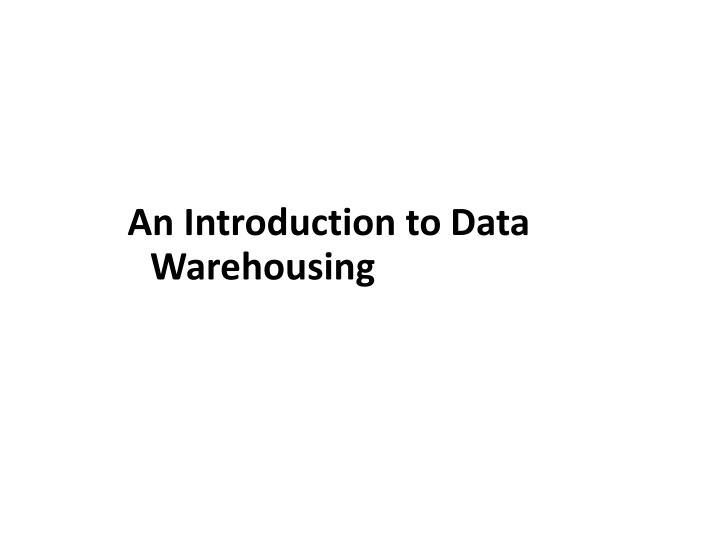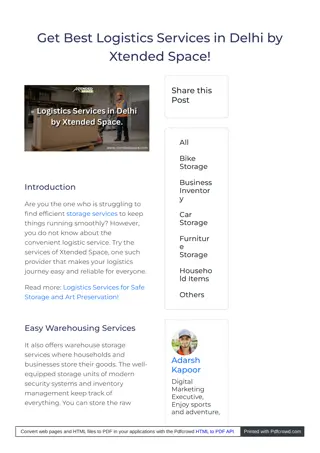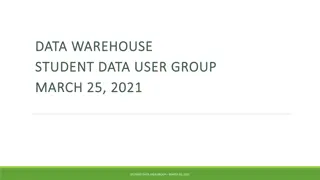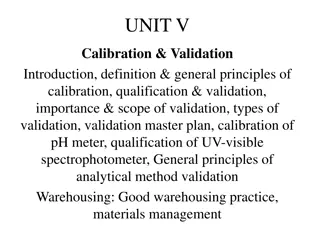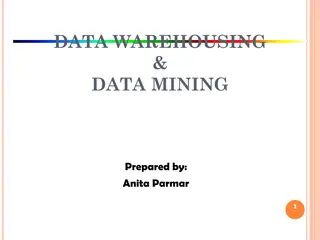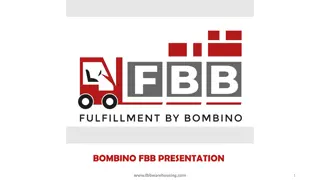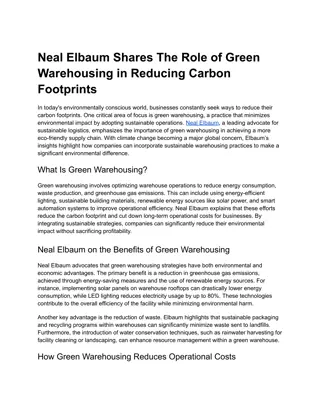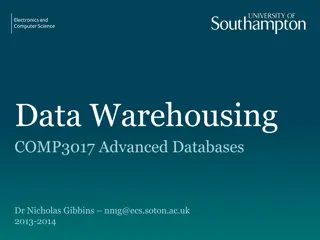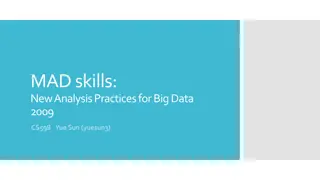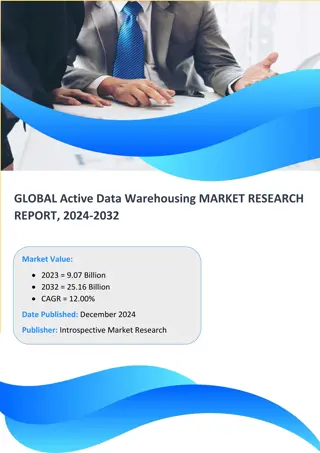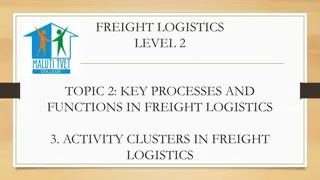Introduction to Data Warehousing
A data warehouse serves as a single, complete, and consistent store of data obtained from various sources, providing end users with accessible information for business use. It offers benefits such as improved query performance, separate research functions, and a foundation for data mining and visualization tools. Data warehouses enable businesses to gain insights, make informed decisions, and enhance operational efficiency through knowledge discovery, consolidated reporting, relationship identification, and data mining examples in various industries.
Download Presentation

Please find below an Image/Link to download the presentation.
The content on the website is provided AS IS for your information and personal use only. It may not be sold, licensed, or shared on other websites without obtaining consent from the author.If you encounter any issues during the download, it is possible that the publisher has removed the file from their server.
You are allowed to download the files provided on this website for personal or commercial use, subject to the condition that they are used lawfully. All files are the property of their respective owners.
The content on the website is provided AS IS for your information and personal use only. It may not be sold, licensed, or shared on other websites without obtaining consent from the author.
E N D
Presentation Transcript
An Introduction to Data Warehousing
Data, Data everywhere yet ... I can t find the data I need data is scattered over the network many versions, subtle differences I can t get the data I need need an expert to get the data I can t understand the data I found available data poorly documented I can t use the data I found results are unexpected data needs to be transformed from one form to other 2
So What Is a Data Warehouse? Definition: A single, complete and consistent store of data obtained from a variety of different sources made available to end users in a what they can understand and use in a business context. [Barry Devlin] By comparison: an OLTP (on-line transaction processor) or operational system is used to deal with the everyday running of one aspect of an enterprise. OLTP systems are usually designed independently of each other and it is difficult for them to share information.
Why Do We Need Data Warehouses? Consolidation of information resources Improved query performance Separate research and decision support functions from the operational systems Foundation for data mining, data visualization, advanced reporting and OLAP tools
Why Data Warehousing? Which are our lowest/highest margin customers ? Who are my customers and what products are they buying? What is the most effective distribution channel? What product prom- -otions have the biggest impact on revenue? Which customers are most likely to go to the competition ? What impact will new products/services have on revenue and margins? 5
What Is a Data Warehouse Used for? Knowledge discovery Making consolidated reports Finding relationships and correlations Data mining Examples Banks identifying credit risks Insurance companies searching for fraud Medical research
How Do Data Warehouses Differ From Operational Systems? Goals Structure Size Performance optimization Technologies used
Comparison Chart of Database Types Data warehouse Subject oriented Operational system Transaction oriented Large (hundreds of GB up to several TB) Historic data Small (MB up to several GB) Current data De-normalized table structure (few tables, many columns per table) Batch updates Normalized table structure (many tables, few columns per table) Continuous updates Usually very complex queries Simple to complex queries
Design Differences Operational System Data Warehouse ER Diagram Star Schema
Supporting a Complete Solution Operational System- Data Entry Data Warehouse- Data Retrieval
Data Warehouses, Data Marts, and Operational Data Stores Data Warehouse The queryable source of data in the enterprise. It is comprised of the union of all of its constituent data marts. Data Mart A logical subset of the complete data warehouse. Often viewed as a restriction of the data warehouse to a single business process or to a group of related business processes targeted toward a particular business group. Operational Data Store (ODS) A point of integration for operational systems that developed independent of each other. Since an ODS supports day to day operations, it needs to be continually updated.
Decision Support Used to manage and control business Data is historical or point-in-time Optimized for inquiry rather than update Use of the system is loosely defined and can be ad-hoc Used by managers and end-users to understand the business and make judgements 12
What are the users saying... Data should be integrated across the enterprise Summary data had a real value to the organization Historical data held the key to understanding data over time What-if capabilities are required 13
Data Warehousing -- It is a process Technique for assembling and managing data from various sources for the purpose of answering business questions. Thus making decisions that were not previous possible A decision support database maintained separately from the organization s operational database 14
Data Warehouse Architecture Relational Databases Optimized Loader Extraction Cleansing Data Warehouse Engine Legacy Data Analyze Query Purchased Data Metadata Repository 15
From the Data Warehouse to Data Marts Information Less Individually Structured History Normalized Detailed Departmentally Structured Organizationally Structured More Data Warehouse Data 16
Users have different views of Data Tourists: Browse information harvested by farmers OLAP Farmers: Harvest information from known access paths Explorers: Seek out the unknown and previously unsuspected rewards hiding in the detailed data Organizationally structured 17
Wal*Mart Case Study Founded by Sam Walton One the largest Super Market Chains in the US Wal*Mart: 2000+ Retail Stores SAM's Clubs 100+Wholesalers Stores This case study is from Felipe Carino s (NCR Teradata) presentation made at Stanford Database Seminar 18
Old Retail Paradigm Suppliers Accept Orders Promote Products Provide special Incentives Monitor and Track The Incentives Bill and Collect Receivables Estimate Retailer Demands Wal*Mart Inventory Management Merchandise Accounts Payable Purchasing Supplier Promotions: National, Region, Store Level 19
New (Just-In-Time) Retail Paradigm No more deals Shelf-Pass Through (POS Application) One Unit Price Suppliers paid once a week on ACTUAL items sold Wal*Mart Manager Daily Inventory Restock Suppliers (sometimes SameDay) ship to Wal*Mart Warehouse-Pass Through Stock some Large Items Delivery may come from supplier Distribution Center Supplier s merchandise unloaded directly onto Wal*Mart Trucks 20
Information as a Strategic Weapon Daily Summary of all Sales Information Regional Analysis of all Stores in a logical area Specific Product Sales Specific Supplies Sales Trend Analysis, etc. Wal*Mart uses information when negotiating with Suppliers Advertisers etc. 21
Schema Design Database organization must look like business must be recognizable by business user approachable by business user Must be simple Schema Types Star Schema Fact Constellation Schema Snowflake schema 22
Star Schema A single fact table and for each dimension one dimension table Does not capture hierarchies directly p r o d T i m e date, custno, prodno, cityname, sales f a c t c u s t c i t y 23
Dimension Tables Dimension tables Define business in terms already familiar to users Wide rows with lots of descriptive text Small tables (about a million rows) Joined to fact table by a foreign key heavily indexed typical dimensions time periods, geographic region (markets, cities), products, customers, salesperson, etc. 24
Fact Table Central table Typical example: individual sales records mostly raw numeric items narrow rows, a few columns at most large number of rows (millions to a billion) Access via dimensions 25
Snowflake schema Represent dimensional hierarchy directly by normalizing tables. Easy to maintain and saves storage p r o d T i m e date, custno, prodno, cityname, ... f a c t c u s t r e g i o n c i t y 26
Fact Constellation Fact Constellation Multiple fact tables that share many dimension tables Booking and Checkout may share many dimension tables in the hotel industry Promotion Hotels Booking Checkout Travel Agents Room Type Customer 27
Data Granularity in Warehouse Summarized data stored reduce storage costs reduce cpu usage increases performance since smaller number of records to be processed design around traditional high level reporting needs tradeoff with volume of data to be stored and detailed usage of data 28
Granularity in Warehouse Solution is to have dual level of granularity Store summary data on disks 95% of DSS processing done against this data Store detail on tapes 5% of DSS processing against this data 29
Levels of Granularity BankingExample account month # trans withdrawals deposits average bal Operational account activity date amount teller location account bal monthly account register -- up to 10 years 60 days of activity amount activity date amount account bal Not all fields need be archived 30
Data Integration Across Sources Trust Credit card Savings Loans Same data different name Different data Same name Data found here nowhere else Different keys same data 31
Data Transformation Operational/ Source Data Sequential Legacy Relational External Data Accessing Capturing Extracting Householding Filtering Reconciling Conditioning Loading Validating Scoring Transformation Data transformation is the foundation for achieving single version of the truth Major concern for IT Data warehouse can fail if appropriate data transformation strategy is not developed 32
Data Transformation Example Data Warehouse appl A - m,f appl B - 1,0 appl C - x,y appl D - male, female appl A - pipeline - cm appl B - pipeline - in appl C - pipeline - feet appl D - pipeline - yds appl A - balance appl B - bal appl C - currbal appl D - balcurr 33
Data Integrity Problems Same person, different spellings Agarwal, Agrawal, Aggarwal etc... Multiple ways to denote company name Persistent Systems, PSPL, Persistent Pvt. LTD. Use of different names mumbai, bombay Different account numbers generated by different applications for the same customer Required fields left blank Invalid product codes collected at point of sale manual entry leads to mistakes in case of a problem use 9999999 34
Data Transformation Terms Extracting Conditioning Scrubbing Merging Householding Enrichment Scoring Loading Validating Delta Updating 35
Data Transformation Terms Householding Identifying all members of a household (living at the same address) Ensures only one mail is sent to a household Can result in substantial savings: 1 million catalogues at Rs. 50 each costs Rs. 50 million . A 2% savings would save Rs. 1 million 36
Refresh Propagate updates on source data to the warehouse Issues: when to refresh how to refresh -- incremental refresh techniques 37
When to Refresh? periodically (e.g., every night, every week) or after significant events on every update: not warranted unless warehouse data require current data (up to the minute stock quotes) refresh policy set by administrator based on user needs and traffic possibly different policies for different sources 38
Refresh techniques Incremental techniques detect changes on base tables: replication servers (e.g., Sybase, Oracle, IBM Data Propagator) snapshots (Oracle) transaction shipping (Sybase) compute changes to derived and summary tables maintain transactional correctness for incremental load 39
How To Detect Changes Create a snapshot log table to record ids of updated rows of source data and timestamp Detect changes by: Defining after row triggers to update snapshot log when source table changes Using regular transaction log to detect changes to source data 40
Querying Data Warehouses SQL Extensions Multidimensional modeling of data OLAP More on OLAP later 41
SQL Extensions Extended family of aggregate functions rank (top 10 customers) percentile (top 30% of customers) median, mode Object Relational Systems allow addition of new aggregate functions Reporting features running total, cumulative totals 42
Reporting Tools Andyne Computing -- GQL Brio -- BrioQuery Business Objects -- Business Objects Cognos -- Impromptu Information Builders Inc. -- Focus for Windows Oracle -- Discoverer2000 Platinum Technology -- SQL*Assist, ProReports PowerSoft -- InfoMaker SAS Institute -- SAS/Assist Software AG -- Esperant Sterling Software -- VISION:Data 43
Decision support tools Mining tools Direct Query Reporting tools OLAP Intelligent Miner Essbase Crystal reports Merge Clean Summarize Relational DBMS+ e.g. Redbrick Data warehouse GIS data Detailed transactional data Operational data Census data Bombay branch Delhi branch Calcutta branch Oracle IMS SAS 44
Deploying Data Warehouses What business information keeps you in business today? What business information can put you out of business tomorrow? What business information should be a mouse click away? What business conditions are the driving the need for business information? 45
Cultural Considerations Not just a technology project New way of using information to support daily activities and decision making Care must be taken to prepare organization for change Must have organizational backing and support 46
User Training Users must have a higher level of IT proficiency than for operational systems Training to help users analyze data in the warehouse effectively 47
Summary: Building a Data Warehouse Data Warehouse Lifecycle Analysis Design Import data Install front-end tools Test and deploy
A case -- the STORET Central Warehouse Improved performance and faster data retrieval Ability to produce larger reports Ability to provide more data query options Streamlined application navigation
